Avast VPN vs NordVPN: Who Beats Whom in 2025?
Find out which VPN is better in this NordVPN vs Avast VPN comparison — Is there any reason to not use the best VPN, NordVPN?
Avast is a name that some readers might already be familiar with. Avast started in the late ‘80s as a cybersecurity software company, and it now protects more than 435 million computers worldwide, making its antivirus the most prolific anti-malware application in existence today.
We thought it would be appropriate to have a matchup between this titan of the anti-virus industry with a titan of the VPN industry, NordVPN. If you look at our NordVPN review, you’ll find that that we consider it to be the best VPN, and it excels in almost every category. So, how does the giant stack up against the newbie in the Avast VPN vs NordVPN showdown?
Before we begin, a brief side note for those who are interested in the antivirus side of Avast’s product line: you can check out our Avast Pro review, but in this article, we’re looking at , which is Avast’s take on VPN software. In our Avast SecureLine VPN review, we found that it offered solid speeds and security while still being easy to use.
Setting up a Fight: NordVPN vs. Avast SecureLine VPN
Editor’s Note 1/28/2020: A report has surfaced showing that Avast and its subsidiaries collect user browsing data from more than 100 million devices. We cannot, in good faith, recommend Avast or AVG products until we look further into the issue.
To compare our two contending VPN providers, we’ve developed a simple structure for these articles. We break things down into five rounds, highlighting one key element of VPN performance in each. In the first round, we look at features, followed by pricing in the second, then ease of use, speed and, finally, security.
Protect Your Privacy. Get Our Free VPN Guide Now!
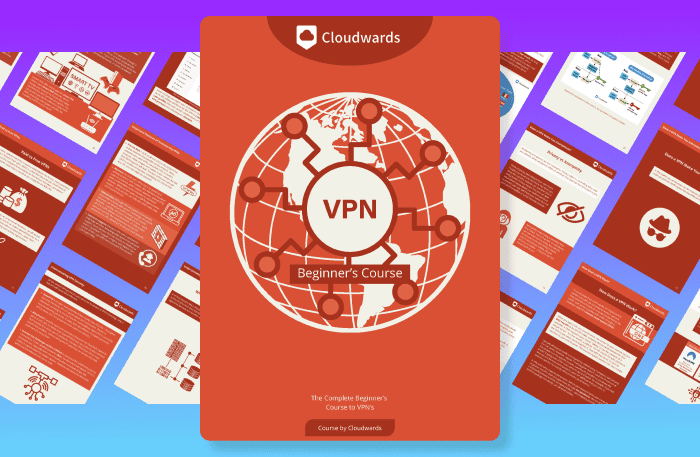
- Comprehend the essential role a VPN plays in safeguarding your digital life
- Gain a deep understanding of how VPNs function under the hood
- Develop the ability to distinguish fact from fiction in VPN promotions
We start each round by briefly noting what it is we look for and what kind of warning signs we don’t want to see. Then we discuss how each VPN performs in the given category. Finally, we wrap up each round by looking at which VPN did better and assigning a point to the winner of the category.
A tie is possible, and if that’s the case, we’ll award a point to each provider for that round. The VPN with the most points at the end is declared the overall winner.
- 2
1. Features
As we do with our best VPN providers, we start off these matchups by evaluating the features that each provider offers. There are a pair of key features we look for: a kill switch and some way to automatically connect to the VPN.
Both of these features have a significant impact on security, and any VPN without one or both of these is almost unusable. Aside from these, features including ad-blockers or split tunneling are nice to see, but they will only earn a VPN extra points and are not considered mandatory.
Avast SecureLine VPN
Even at first glance, Avast SecureLine VPN’s interface looks barren. Heading into the settings only reinforces this sense of emptiness.
The settings consist of three tabs, each with only a sparse few checkboxes. Starting with the general tab, there is an option to turn on or off notifications from the software, a checkbox for whether the client runs on startup and the option to opt in or out of beta updates.
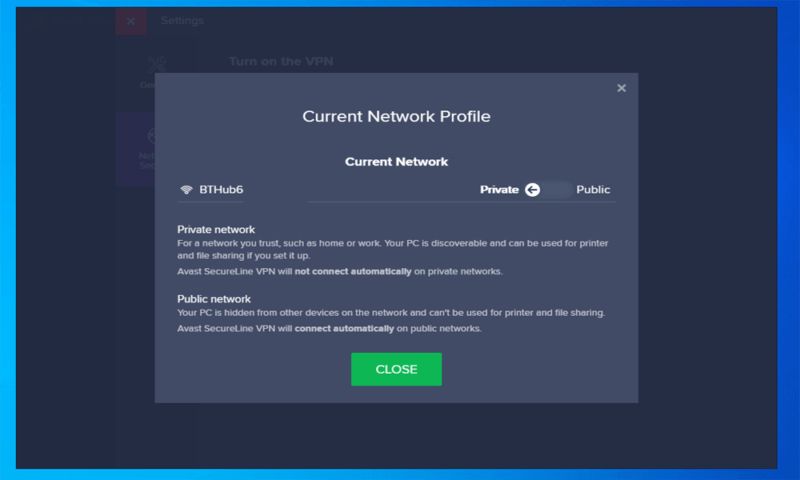
This beta feature could jeopardize the stability of your VPN, which is something Avast points out itself. The second tab is labeled “network security” and gives you some options related to connecting the VPN automatically.
The network security page is also where the kill switch is, which for us was turned off by default. For those who are using SecureLine VPN, we suggest making sure this is turned on to maximize security because, without it, your VPN could disconnect without you noticing, and you could continue making online purchases or looking at private information without any protection.
The final tab does not have any checkboxes, but instead gives users a one-click way to install the Avast SecureLine . Although Avast covers the bare-minimum features that we mentioned, that’s all it does. There are no extra features beyond those that are mandatory.
NordVPN
NordVPN is the best when it comes to features, as we saw in our NordVPN vs TorGuard article, and it has quite a few tricks up its sleeve. Starting with the essentials, NordVPN has a robust and fleshed-out kill switch that is more than just a checkbox.
There is an internet kill switch, which works the same as the Avast SecureLine kill switch and others, blocking internet traffic when the VPN is disconnected. In addition, there is also an app kill switch. This lets you define a list of programs that NordVPN will close if the connection to the VPN is lost (read our Astrill review for another service with app kill).
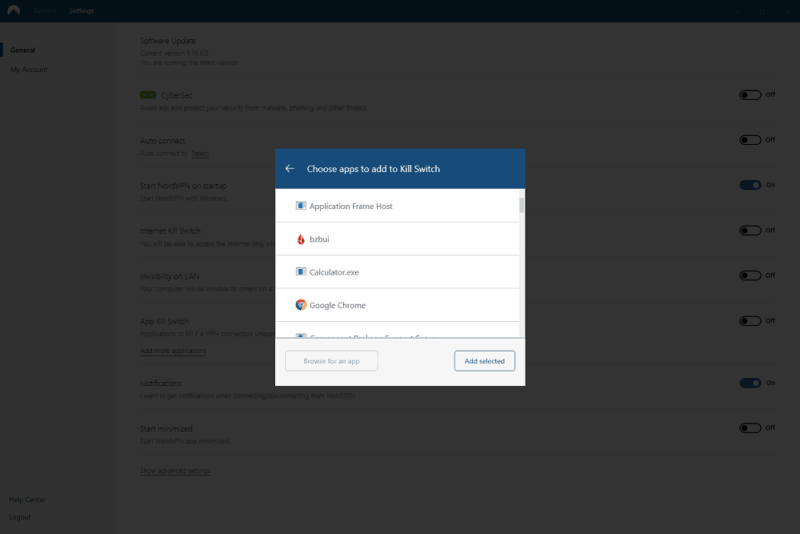
There are also auto-connect options that allow you to either connect when the application starts or when an untrusted network is detected, which is a great defense against the dangers of public WiFi.
Unlike Avast SecureLine VPN, NordVPN also lets you choose where the VPN links to when it connects automatically. If you don’t have a specific location in mind, then you can also choose a region to connect to and NordVPN will automatically pick a fast server.
As for extras, NordVPN has recently added a feature called CyberSec, which helps you stay safe online by blocking sites with malware or phishing attempts. CyberSec also works as an ad-blocker.
Although it’s not quite as effective as a dedicated ad-blocker, such as the ones on our 99 free tools to protect your privacy roundup, it’s a nice feature to have. NordVPN also has the option to use obfuscated servers, which allows people in places where VPN use is restricted to still connect to the NordVPN network.
Round One Thoughts
Avast SecureLine VPN covers the most basic features and stops there. NordVPN goes above and beyond, with the basics including an app kill switch and several options to customize how the auto-connect behaves.
On top of that, NordVPN throws in a number of extra goodies, such as an ad- and malware-blocker and obfuscated servers. This first round is a cut-and-dry win for NordVPN.
2. Pricing
When shopping for anything, one of the first things — if not the first thing — people want to know is the price. That’s why we’ve dedicated the second section to investigating this, but we don’t stop with just looking at the price.
We also look at what kind of refund policy is available and whether there is any kind of free trial. Additionally, we factor in what kind of payment options are accepted and what the plan includes, such as how many simultaneous connections are allowed.
Avast SecureLine VPN
Avast SecureLine VPN has an unnecessary number of plans and pricing options. There is the option to get only a single-device license for either an Android or a single iPhone or iPad, which comes in at only a few bucks a month.
There is also the option to get a single-device license for a desktop or laptop that runs either Windows or macOS. These plans are not available in a monthly time frame and have to be purchased in one-, two- or three-year durations.
All three of these time frames, however, have pretty much the same monthly cost, which comes in at about five bucks. Finally, there is also the option to purchase a plan that covers up to five devices of any variety, including mobile, Windows and macOS.
This plan is available in all four time frames, ranging from a month to three years. The monthly pricing is decent, coming in at a few dollars a month less than the top-tier competitors. The yearly plan cuts this down a couple of dollars, while the two- and three-year options don’t bring the per-month price down more than a few dimes.
When it comes time to check out, Avast SecureLine VPN accepts either credit cards or PayPal, but no forms of cryptocurrency. Before buying, Avast offers potential users a 60-day free trial on desktop, and a one-week free trial that is easy to set up. It also covers your purchase with a .
NordVPN
NordVPN’s lineup of plans is much simpler than Avast SecureLine VPN. There is only one plan, which is available in four time frames. The monthly pricing is what we’d expect to see from top-shelf VPNs and certainly isn’t an impressive deal to anyone.
- **VAT may apply
- Unlimited GB
- 10
- Yes
- *The prices are charged in the first billing cycle only. Renewal prices vary.
- Unlimited GB
- 10
- Yes
- *The prices are shown only apply for the first 12 months.
- Unlimited GB
- 10
- Yes
- **The prices are applicable only for the first 24 months. Secure, high-speed VPN Threat Protection Pro™: Anti-malware and advanced browsing protection Threat Protection Pro™: Ad and tracker blocker Password manager with Data Breach Scanner 1 TB of encrypted cloud storage Identity and SSN monitoring and alerts Credit monitoring services Up to $1M in identity theft insurance Up to $100K in cyber extortion insurance
- 10
The annual plan, however, cuts this price in half, bringing the monthly cost nearly in line with Avast SecureLine VPN’s annual pricing. NordVPN’s two- and three-year plans bring this price down even further, making it a more budget-friendly option than even Avast’s single-device Windows or Mac plan.
Not only that, but NordVPN’s plans all include up to six simultaneous connections. Although NordVPN doesn’t offer any kind of free trial, it does match Avast SecureLine VPN’s 30-day refund policy. This means that if the service doesn’t work as you’d expect, there is still a way to get your investment back.
NordVPN also accepts more payment types than Avast SecureLineVPN, including credit card, PayPal, UnionPay, Alipay and even bitcoin. Although NordVPN isn’t unbeatable when it comes to pricing — as we saw in our NordVPN vs. PureVPN article — its three-year pricing is among the best.
Round Two Thoughts
Although Avast SecureLine VPN does offer a free trial, it’s not the best we’ve seen (that would probably go to ProtonVPN, which you can read about in our ProtonVPN review). Avast’s free trial is the only leg up it has over NordVPN.
NordVPN offers a pricing model that’s easier to understand and more connections per account, accepts more forms of payment and even has better pricing if you go with the three-year option. Although the pricing of Avast SecureLine’s single mobile device plan is hard to beat, this plan is a niche option that many people would not be interested in.
3. Ease of Use
Ease of use is something that is hard to pin down in an objective way, but it is still something that is undeniably important. A well-constructed software tool can make complex tasks easy, while a poorly designed one can make simple tasks frustrating and time consuming.
In this round, we describe the layout of each VPN and what it’s like to use. We look high and low for problems, and we even try to cause a bit of havoc with the software by causing random disconnections and opening other demanding software programs while running the VPN to try to cause crashes and instability.
Avast SecureLine VPN
As we already saw in the features section, Avast SecureLine VPN takes a very minimalist approach to its UI. The window is a bit larger than most VPNs, but there is very little to fill in this space.
Nearly the top two-thirds of the window is occupied by a toggle switch for connecting and disconnecting the VPN. Below this, it shows your IP when unprotected, as well as your protected IP and connection time once you’re turned on the VPN.
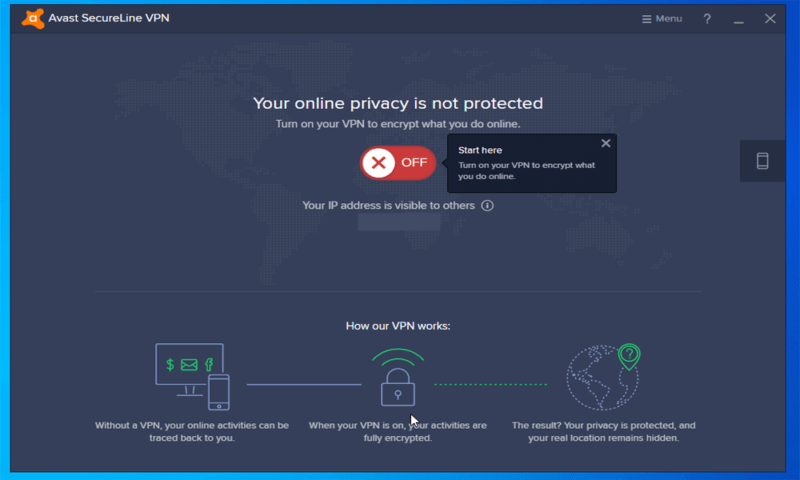
The bottom third of the window displays the flag of the country you’ve currently selected and the name of the location in text. There is a button labeled “change location” that expands the full server list, which takes up the whole window when opened and is well organized.
You can browse all the available locations in an alphabetized list or pick one of the tabs on the left, which has the locations grouped by continent, as well as a couple of extra tabs for things like dedicated streaming servers.
The settings — seeing as there are so few — are easy to find. All of the options are also explained in a line or two to help first-time VPN users find their way around. The client is stable, and we didn’t experience any crashes, but there was one peculiarity with the software.
When you click and drag the window to move it around, it causes a strange low frame rate effect. The window moves slower than the mouse and shifts in a stuttering manner rather than smoothly. It also continues to move for a second or two after you let go of the mouse or if you change directions, making it almost impossible to place the window where you want.
Overall, Avast SecureLine VPN’s client seems like a fire-and-forget solution for those who don’t want to have to mess with any settings, but it also has the glaring flaw of slowing the entire computer down momentarily when being dragged around.
NordVPN
Even at first glance, NordVPN’s interface feels more fleshed out than Avast SecureLine VPN’s. Rather than having a large and mostly empty window, the right two-thirds of the client is taken up by a map that shows all the available locations with blue markers.
You can click on the marker in your desired connection location, or you can use the list of servers on the left side of the window. NordVPN doesn’t have any grouping options like Avast SecureLine VPN does, but it has a search bar to help find locations.
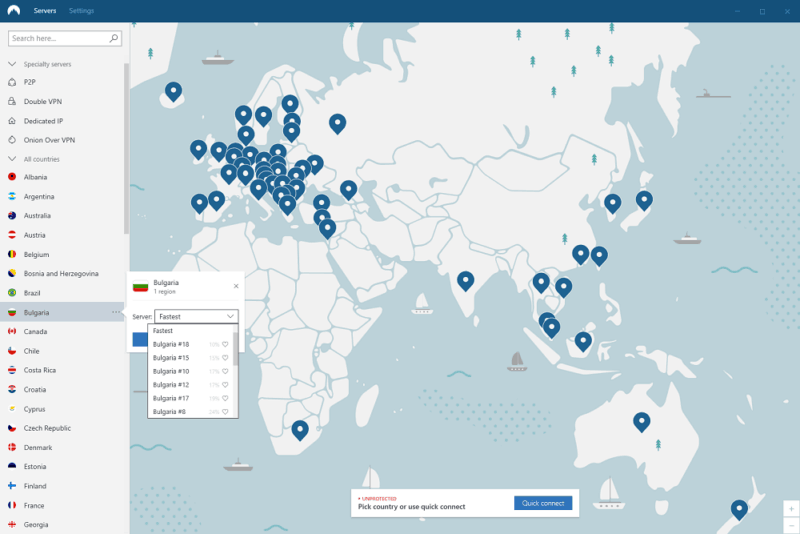
Moving into the settings, NordVPN has much more to offer than Avast SecureLine VPN, but it does a good job of keeping them manageable. There are only three tabs of settings and one for account information.
The three settings tabs are “general,” “auto-connect” and “advanced.” The “general” page hosts most of the features that a majority of users will ever need, and the “auto-connect” page is accurately named, containing all the relevant settings for how and when the VPN connects automatically.
The “advanced” tab has protocol and DNS options that most users won’t need to bother with. NordVPN’s client is well optimized and only needs small sips of system resources. We weren’t able to induce any crashes or issues with the software, and everything runs smoothly with the client open, whether it’s connecting, already connected or just idling.
Round Three Thoughts
Avast SecureLine VPN’s client is streamlined and easy to use. It seems that by foregoing features, Avast aimed to make a VPN that anyone could use with ease and, in many ways, it achieved that.
However, we did have an issue with dragging the window, which wasn’t present with NordVPN. Additionally, the smaller yet still more robust layout of NordVPN’s map-based design lends itself to user-friendliness in its own ways. NordVPN takes this round, mainly due to Avast SecureLine VPN’s problem with repositioning the window.
4. Speed
In round four, we move away from the realm of the subjective and enter the world of hard data. To test the speed of each VPN, we measure the ping time, download speeds and upload speeds of each VPN in five different locations, ranging from practically next door to across the globe.
We compare this with our control measurement without any VPN to see just how well each provider is performing. We also take our testing into the real world to confirm our results on paper by loading up some streaming videos and downloading some larger files to see how things go.
Avast SecureLine VPN
Avast SecureLine VPN takes a bit of time to form a connection, ranging from about five seconds all the way up to 10 seconds. Once connected, performance varies significantly from country to country.
| Location: | Ping (ms) | Download (Mbps) | Upload (Mbps) |
|---|---|---|---|
| Unprotected (UK) | 13 | 194.30 | 12.24 |
| Germany | 49 | 191.78 | 9.74 |
| Russia | 114 | 39.39 | 6.03 |
| Brazil | 228 | 41.30 | 1.12 |
| U.S. | 85 | 75.04 | 2.62 |
| South Korea | 472 | 18.94 | 3.07 |
In the U.S. and UK, we saw a very respectable performance with low ping times and triple-digit download speeds. However, in Japan and Brazil, performance fell off considerably. Ping times were still within reason, given the vast distances involved, but download speeds dropped to serviceable — albeit unimpressive — levels.
When it came time to actually test the performance of Avast SecureLineVPN, we found that things were a bit sluggish to get started. Websites and videos would take an extra two or three seconds to start loading, but once things started loading, everything seemed to function normally. After the initial loading time, videos defaulted to 1080p and didn’t need to buffer.
NordVPN
As we’ve discussed many times before, such as in our NordVPN vs IPVanish article, NordVPN has had some issues when it comes to providing consistent speeds. In fact, it even got a dishonorable mention in our fastest VPN services roundup for this reason.
| Location: | Ping (ms) | Download (Mbps) | Upload (Mbps) |
|---|---|---|---|
| Unprotected | 9 | 165.5 | 10.57 |
| U.S. #2479 | 23 | 133.53 | 8.87 |
| United Kingdom #201 | 153 | 34.78 | 6.06 |
| Netherlands #66 | 145 | 66.91 | 5.39 |
| Japan #69 | 159 | 132.83 | 3.31 |
| Double VPN (U.S. to Canada #4) | 79 | 20.48 | 8.64 |
From one server to another, even in the same location, speeds can range from excellent to practically unusable. It seems to come down to luck of the draw, and most of the time simply disconnecting and reconnecting can remedy this by connecting you to a different server.
That said, we actually didn’t experience this problem at all this time around, meaning NordVPN might be working on this issue. In our testing for this article, speeds were rock solid across the board with every single location returning triple-digit download and upload speeds.
When it came to real-world use, the performance is just as good as the numbers would suggest. Even the most distant server, Japan, felt very responsive, and there was very little perceptible delay before things started loading.We were able to easily watch 1080p videos, even at 60fps, without any buffering issues.
Round Four Thoughts
Even though NordVPN has proven troublesome in the past, its performance in our testing for this article shows signs of improvement. Every single server we tested had excellent speeds on paper and performed just as well as the numbers would suggest in our real-world testing.
Avast SecureLine VPN was usable across the board but had much more variation from server to server than NordVPN. Avast SecureLine VPN also felt less responsive than NordVPN and took a moment before websites began loading, while NordVPN felt instant by comparison.
5. Security & Privacy
NordVPN has won every round so far, making the score four to none, meaning it’s impossible for Avast SecureLine VPN to win overall, despite this final round. That said, we’ve saved what might be the most important section for last: security and privacy.
In this round, we look at what protocols and encryptions each VPN uses and test for things, such as DNS leaks. We also look back at each VPN’s history to see if there is a track record of security or a background of breaches.
Additionally, we delve into the privacy policies of each provider to see what kind of information is gathered and how it is used.
Avast SecureLine VPN
As we’ve already mentioned, Avast SecureLine VPN doesn’t give users much in the way of options, so both the protocol and encryption are locked in and depend on the device you’re using.
For those who are on Windows and Android devices, uses the OpenVPN protocol. If you check out our VPN protocol breakdown, you’ll see that this is a highly trusted and open-source protocol.
Those on iOS and macOS devices, however, will be using IKEv2, which is less secure than OpenVPN but still offers a respectable level of protection. For encryption, Avast SecureLine VPN pairs both protocols with AES-256, which is a top of the line encryption.
Rather than having a privacy policy that specifically pertains to the SecureLine VPN, Avast has a single privacy policy that covers all of its products and services. Because of this, the policy is expansive and goes on for a staggering 39 pages.
Toward the very bottom of this 39-page epic is the information that specifically relates to the VPN. In this section, it states that Avast SecureLine VPN collects information, including what operating system you’re using, a portion of your IP address (though not enough of it to be identifying) and which server you’re using.
Additionally, throughout other sections of the privacy policy, things like “information on your interests” are mentioned as things that Avast might gather about you. It’s also shown in this policy that the information Avast gathers is shared with numerous third parties.
The sheer length of this privacy policy and some of the wording throughout are a bit concerning and don’t quite offer a clear picture of exactly how much Avast aims to learn about you through the use of its products.
NordVPN
Much like Avast SecureLine VPN, NordVPN doesn’t provide any real choices for consumers when it comes to protocol and encryption. Instead, it locks users into the combination of OpenVPN and AES-256, which, it just so happens, is exactly what we suggest most people use. This combo offers solid performance and excellent security.
However, as those of you who have been paying attention to tech news might already know, NordVPN recently had a security breach. In short, hackers were able to steal a TLS key, which allowed them to launch what is called a “man in the middle” attack.
This means that the hackers could set up a server to appear as though it was one of the servers on NordVPN’s actual network. Users could have been unknowingly connecting to this fake server, giving the hackers access to their information.
This same vulnerability has since been discovered in other VPN networks, and NordVPN has patched this issue and continues to work to ensure that this kind of thing can never happen again, but regardless, this is a permanent stain on NordVPN’s track record.
Moving on to the privacy policy, NordVPN keeps things concise and does a reasonably good job of avoiding excessive legal jargon. The only information NordVPN needs from you to set up an account is an email address, and there’s nothing stopping you from using a fake throwaway email for this.
The VPN itself does not collect any identifying information. The data gathered pertaining to your use of the VPN is limited to things like server load, which is used to maintain the network.
Round Five Thoughts
Both NordVPN and Avast SecureLine VPN offer what we consider the gold standard for VPN security: OpenVPN and AES-256. However, Avast SecureLine VPN only offers this on certain platforms, while NordVPN has recently had a major security breach.
NordVPN has written a solid privacy policy that is reasonably short and written in a way that almost anyone can understand. Avast, on the other hand, has a ridiculously long privacy policy that can often leave you with more questions than answers.
Between NordVPN’s breach and Avast SecureLine VPN’s privacy policy, it kind of seems like both of these providers need to clean up their acts a bit. This round ends in a tie.
6. Final Thoughts
In a five-to-one victory, NordVPN has proven why it is one of the most prolific VPNs on the market today. It outpaced Avast SecureLine VPN from start to finish with higher speeds, more features and a more user-friendly interface.
Winner: NordVPN
For some reason, antivirus companies struggle to compete in the VPN market, as we’ve seen in other instances, such as in our Avast VPN vs ExpressVPN comparison and our Bitdefender VPN review. It seems the kind of specialization required to compete in the VPN market and the network investment required creates a barrier to entry for firms in other parts of the cyber-security world.
If you’ve used either of these VPNs before, we always love to hear your thoughts on them in the comments below. As always, thanks for reading.
